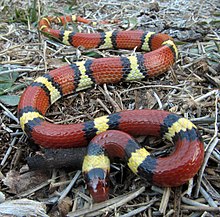Scarlet Kingsnake
| Scarlet kingsnake | |
|---|---|
 |
|
| Adult Lampropeltis elapsoides in Florida | |
| Scientific classification | |
| Kingdom: | Animalia |
| Phylum: | Chordata |
| Class: | Reptilia |
| Order: | Squamata |
| Suborder: | Serpentes |
| Family: | Colubridae |
| Genus: | Lampropeltis |
| Species: | L. elapsoides |
| Binomial name | |
|
Lampropeltis elapsoides (Holbrook, 1838) |
|
| Synonyms | |
Lampropeltis elapsoides, commonly known as the scarlet kingsnake, is a species of kingsnake found in the southeastern and eastern portions of the United States. Like all kingsnakes, they are nonvenomous. They are found in pine flatwoods, hydric hammocks, pine savannas, mesic pine-oak forests, prairies, cultivated fields, and a variety of suburban habitats; it is not unusual for people to find scarlet kingsnakes in their swimming pools, especially during the spring. Until recently - and for much of the 20th century - scarlet kingsnakes were considered a sub-species of milksnakes. However, Pyron & Bubrink demonstrated the phylogenetic distinction of this species and its closer relationship to the mountain kingsnakes of the southwestern United States. These largely fossorial snakes are the smallest of all species within the genus Lampropeltis, usually ranging from 40 to 50 cm (16 to 20 in) at maturity. The maximum recorded length is 68.4 cm (26.9 in). Hatchlings range in size from 8 to 18 cm (3.1 to 7.1 in).
The generic name, Lampropeltis, is derived from the Ancient Greek lamprós (λαμπρος) meaning "shiny" and peltas (πελτας) meaning "shield", after the sheen of their scales. Its specific name, elapsoides, is a Latinization of the Greek word éllops (ελλοπς) which refers to coral and was used to describe the nineteenth century genus, Elaps (type genus of the family Elapidae), which included the coral snake (Micrurus fulvius), a venomous species which the scarlet kingsnake resembles and with which the scarlet kingsnake is partly sympatric. The range of scarlet kingsnakes extends considerably further north and northeast than the Eastern coral snake.
...
Wikipedia
